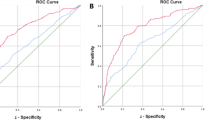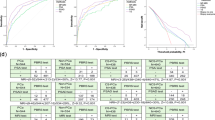Abstract
The object of the study was to examine the usefulness of volume-adjusted prostate-specific antigen (PSA) parameters for prediction of prostate cancer in the patients with intermediate PSA levels. The subjects were 235 patients with intermediate PSA levels (range: 4.1–10.0 ng/ml) whose prostate volume (PV) and prostate transition zone volume (TZV) were evaluated between August 1996 and April 2004. PSA, PV, TZV, PSA density (PSAD) (PSA/PV) and PSA transition zone density (PSATZD) (PSA/TZV) were assessed with the receiver operating characteristic (ROC) curve and the area under the curve (AUC). Simple and multivariate logistic regression analyses were used to analyze the odds ratios of age, PSA, PSAD, PSATZD, PV, TZV, digital rectal examination (DRE) and transrectal ultrasonography (TRUS) findings. Fifty-five patients (23.4%) of 235 patients had biopsy-proven prostate cancer. The univariate analysis revealed significant differences in the mean values of age, PSAD, PSATZD, PV, TZV and DRE between the patients with cancer and the non-cancer patients. The ROC curve analysis revealed that PV, TZV, PSAD and PSATZD had significant predictive values as compared with that of PSA. However, there was no difference in AUC between them. The stepwise logistic regression analysis showed that the age, PV, PSATZD and DRE had significant predictive values, and that PSATZD had the most predictive power. In conclusion, both PSAD and PSATZD had significant predictive values in discriminating prostate cancer. Furthermore, the stepwise logistic regression analysis showed that PSATZD had the strongest predictive value.
This is a preview of subscription content, access via your institution
Access options
Subscribe to this journal
Receive 4 print issues and online access
$259.00 per year
only $64.75 per issue
Buy this article
- Purchase on Springer Link
- Instant access to full article PDF
Prices may be subject to local taxes which are calculated during checkout

Similar content being viewed by others
References
Benson MC, Whang IS, Pantuck A, Ring K, Kaplan SA, Olsson CA et al. Prostate specific antigen density: a means of distinguishing benign prostatic hypertrophy and prostate cancer. J Urol 1992; 147: 815–816.
Benson MC, Whang IS, Olsson CA, McMahon DJ, Cooner WH . The use of prostate specific antigen density to enhance the predictive value of intermediate level of serum prostate specific antigen. J Urol 1992; 147: 817–821.
Kalish J, Cooner WH, Graham Jr SD . Serum PSA adjusted for volume of transition zone (PSAT) is more accurate than PSA adjusted for total gland volume (PSAD) in detecting adenocarcinoma of the prostate. Urology 1994; 43: 601–606.
Arai Y, Maeda H, Ishitoya S, Okubo K, Okada T, Aoki Y . Prospective evaluation of prostate specific antigen density and systematic biopsy for detecting prostate cancer in Japanese patients with normal rectal examinations and intermediate prostate specific antigen levels. J Urol 1997; 158: 861–864.
Egawa S, Suyama K, Takashima R, Mizoguchi H, Kuwao S, Baba S . Prospective evaluation of prostate cancer detection by prostate-specific antigen-related parameters. Int J Urol 1999; 6: 493–501.
Djavan B, Zlotta AR, Byttebier G, Shariat S, Omar M, Schulman CC et al. Prostate specific antigen density of the transition zone for early detection of prostate cancer. J Urol 1998; 160: 411–419.
Kikuchi E, Nakashima J, Ishibashi M, Ohigashi T, Asakura H, Tachibana M et al. Prosate specific antigen adjusted for transition zone volume. Cancer 2000; 89: 842–849.
Imai K, Ichinose Y, Kubota Y, Yamanaka H, Sato J, Saitoh M et al. Clinical significance of prostate specific antigen for early stage prostate cancer detection. Jpn J Clic Oncol 1994; 24: 160–165.
Matsuyama H, Baba Y, Yamanaka G, Yamamoto N, Naito K . Diagnostic value of prostate-specific antigen-related parameters in discriminating prostate cancer. Int J Urol 2000; 7: 409–414.
Maeda H, Arai Y, Aoki Y, Okubo K, Okada T, Maekawa S . Complex prostate-specific antigen and its volume indexes in the detection of prostate cancer. Urology 1999; 54: 225–228.
Kang SH, Bae JH, Park HS, Yoon DK, Moon DG, Kim JJ et al. Prostate-specific antigen adjusted for the transition zone volume as a second screening test: a prospective study of 248 cases. Int J Urol 2006; 13: 910–914.
Hanley JA, McNeil BJ . The meaning and use of the area under a receiver operating characteristics (ROC) curve. Radiology 1982; 143: 29–36.
Hanley JA, McNeil BJ . A method of comparing the area under receiver operating characteristic curve derived from the same cases. Radiology 1983; 148: 839–843.
Author information
Authors and Affiliations
Corresponding author
Rights and permissions
About this article
Cite this article
Tanaka, N., Fujimoto, K., Chihara, Y. et al. Prostatic volume and volume-adjusted prostate-specific antigen as predictive parameters for prostate cancer patients with intermediate PSA levels. Prostate Cancer Prostatic Dis 10, 274–278 (2007). https://doi.org/10.1038/sj.pcan.4500957
Received:
Revised:
Accepted:
Published:
Issue Date:
DOI: https://doi.org/10.1038/sj.pcan.4500957
Keywords
This article is cited by
-
The optimal number of initial prostate biopsy cores in daily practice: a prospective study using the Nara Urological Research and Treatment Group nomogram
BMC Research Notes (2015)
-
Photodynamic diagnosis of shed prostate cancer cells in voided urine treated with 5-aminolevulinic acid
BMC Urology (2014)
-
Utility of the transition zone index for identification of prostate cancer in Chinese men with intermediate PSA levels
International Urology and Nephrology (2012)



